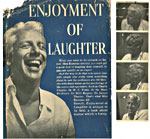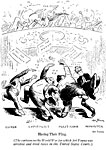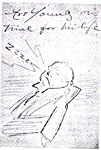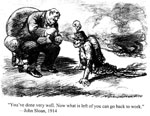Max Eastman and The Masses
An Lost Moment in the History of Cartooning
Whilst
wandering lonely as a cloud in a foreign clime some weeks ago, I toured a
couple nifty dusty old bookstores (the dust was a big part of the nift) and
chanced upon a tome called Enjoyment of
Laughter, a 1936 opus by Max Eastman. It was the author’s name that stopped
me. Wasn’t Max Eastman, I asked myself, the editor of the rabble-rousing
socialist magazine, The Masses, back
in the 19-teens? While the magazine published excellent cartoons by Art Young,
George Bellows, Robert Minor, and John Sloan among others, I didn’t think its
editor (who, it turns out, was indeed Max Eastman) was renowned for his keen
sense of humor. He may not have been much renowned for it, but he had one,
enough to prompt him to write this 360-plus page book on the subject.
The
Masses, in case you have mislaid
your remembrance of it, commenced in January 1911, the property and inspiration
of a displaced Dutchman, Piet Vlag. After a year and a half, the magazine was
foundering for lack of income, and Vlag deserted it. But its contributors,
including Young and Sloan, were reluctant to give up the ghost, so they held a
meeting and decided to keep it going as a sort of co-op enterprise. They needed
an editor, and they “elected” Eastman, whose chief qualification for the post,
it seems, was his absence from the meeting. At the moment, Eastman was
finishing a dissertation in philosophy under John Dewey at Columbia University
and was already making a name for himself as a public speaker and poetry theoretician.
He had recently quit a teaching job to devote himself full-time to writing, and
he told them he didn’t want to be an editor and he wasn’t looking for a job
that came without salary. They reassured him: the editing, they said, would be
done by the members of the co-op; and they would be happy to pay him something
once the magazine got on its feet.
Eastman, without committing himself,
agreed to attend their next meeting, and there he discovered “the most
fascinating sport”—namely, pasting up the printer’s dummy for the magazine,
which involved cutting up galleys of type and configuring it around pictures
and cartoons and the like. He wrote about it afterwards: “You take a previous
issue of the magazine and, with a mighty pair of scissors and a brimming pot of
mucilage, insert, in whatever pattern pleases you, the new material in the old
forms. ... This art combines the infantine delight of cutting out paper dolls
... with the adult satisfaction of fooling yourself into thinking you are
molding public opinion.” Enthralled, Eastman agreed to stay on for an issue or
two to see if fund-raising efforts could generate a salary for him. There was
never much money, I suspect, but the fascination endured, and so did Eastman.
He was a charismatic personality.
Without ever seeing a photograph of him, I’ve always pictured him in my mind as
a scruffy Trotsky-like revolutionary, all askew hair and shaggy He needed all of these skills to
keep the magazine going. The free-for-alls that passed for editorial
conferences needed a referee, and he proved an adroit one. On one occasion, a
drawing inspired the group to split into two opposing camps, one insisting that
it be published, the other threatening to quit if the drawing was printed in
the magazine. Eastman settled the dispute by deciding to publish the drawing on
the cover. Since it was not “in” the magazine, those opposed to it were given a
face-saving escape hatch, and they took it, remaining in the co-operative.
The general editorial posture of the
magazine leaned away from the conventions of the establishment and toward the
eccentricities of bohemians everywhere. Politically, the magazine was more
socialist than anything else, and in those days, before the U.S. entry into
World War I and before the Russian Revolution, socialism wasn’t a bad thing.
But when the U.S. joined the hostilities in Europe, The Masses came out ringingly against the War. It’s mailing
privileges were promptly revoked by the Post Office, which was empowered under
the June 1917 Espionage Act to withhold from distribution anything that
promoted “treason, insurrection or forcible resistance to any law of the United
States.” While there was scarcely anything in the magazine advocating the use
of force, there was plenty that voiced serious reservations about going to
war—hence, resistance to authority and the government. In one of Henry
Glintenkamp’s cartoons, for example, a skeleton is depicted measuring a man in
front of a stack of coffins; coupled to the caption, “Physically Fit,” It was the first “Roe vs.” case: the
lawyer for the magazine was Gilbert Roe, who argued that although such cartoons
as those I’ve described criticized the government, none of them threatened to
obstruct or overthrow it. At the first court encounter, the judge agreed, but
the government appealed, and the Circuit Court upheld, for the moment, the
decision not to mail the August 1917 issue. The legal machinery clanked on,
ponderous and slow, while the editors assembled the next issue for September.
Oddly, when they presented that issue for mailing, the postmaster revoked its
mailing privileges on the grounds that it had skipped a month of mailing and
therefore no longer qualified as a “monthly periodical.” On appeal, the judge
admitted tha If all of this sounds suspiciously
like it could happen here even today, despite our advanced state of
civilization since the early years of the last century, you might be right. As
a society, human sapiens doesn’t learn much or very fast: it tends to repeat
itself relentlessly, particularly when reacting to events out of fear. Today we
scoff at the hysterical absurdity that resulted in Rudolph Dirks’ renaming his
German juveniles comic strip The Captain
and the Kids so that the previous name, the Teutonic-sounding Hans and Fritz, would not offend the
sensibilities of a nation now chanting hatred for Kaiser Bill and his Germanic
hordes. (Dirks’ original Katzenjammer
Kids, then being produced by Harold Knerr, was re-named The Shenanigan Kids for the same
reason.) But not so long ago, in a fit of identical logic, we blithely changed
the name of French fires to freedom fries.
None of our political cartoonists
have been indicted yet for expressing anti-Iraq invasion views, but it’s pretty
clear that the Bush League is expert at intimidating the owners and publishers
of the organs of mass media. In the first blush of 9/11 hysterias, the news
media, in the spirit of patriotic unity that then prevailed, went along with
whatever the government proposed; intimidation was hardly necessary. Later, the
veiled presence of Darth Cheney and his minions was widely acknowledged, but by
then, few were any longer intimidated by government. By public opinion—or fear
about what they imagined public opinion might be—yes; but not by government.
Still, even though we remain vulnerable to our basest fears and trepidations,
our political cartoonists have expressed themselves mostly in the outspoken
unfettered spirit of The Masses cartoonists.
And for that, we must be everlastingly grateful. Still, not all subjects are
fair game for editoonists. The Prophet Muhammad isn’t, and, more sinisterly, we
have learned, alas, that criticizing Israel is so often translated into
anti-Semitism that the Jewish state is virtually immune from attacks by
cartoonist critics.
Max Eastman, after The Masses expired, immediately founded
another left-leaning magazine, Liberator,
which he continued until he went to Russia in 1922, spending two years there,
studying the language and the soviet experiment and the Maxian theories
underpinning it. When Eastman returned to the U.S., he came with a wife, a
Russian dancer and painter named Eliena Krylenko, “whose importation [the book
jacket says] is considered one of his principal achievements.” He wrote a
biography of Leon Trotsky and translated Trotsky’s History of the Russian Revolution. He also produced a dozen or so
books about poetry, art, journalism and history, plus The Sense of Humor and Art
and the Life of Action, to name two of the more intriguing titles. And, in
1936, came the book at hand, which he offered as a model for textbooks.
Textbooks, he said, should begin
with a few succinct statements of principle or a short outline of content;
then, in subsequent chapters, elaborate upon those statements, fleshing them
out. He begins by stating that “the first law of humor is that things can be
funny only when we are in fun.” “In fun,” he explains, describes a playful
mood, a “condition natural to childhood.” This principle with a couple nuances
he states on a single page at the front of the book; the rest of the book
embroiders endlessly upon these themes.
Eastman allows, at the very beginning,
that “nothing kills the laugh quicker than to explain a joke. I intend to
explain all jokes, and the proper and logical outcome will be, not only that
you will not laugh now, but that you will never laugh again. So prepare for the
descending gloom.” You can see, readily enough, that Eastman has a sense of
humor: he is prepared to laugh, even, at himself. He quotes various humorists
on assorted subjects, interviewing several for the purpose; and he quotes
humorous texts, too. He also reprints several cartoons by such worthies as
Peter Arno, William Steig, Rube Goldberg, James Thurber, Al Frueh, Thomas Nast,
H.T. Webster, Otto Soglow, and Art Young, among others, most of whose names no
longer mean much to us.
In one of his discussions of some
cartoons, Eastman champions pictures that are inherently funny as opposed to
those that merely illustrate jokes. In the former, “the wit is not so much
illustrated as enriched by the picture.” From funny pictures, we slide easily
to gag cartoons in which the comedic import of the picture is “explained” by
the caption beneath—in which, to repeat myself, the visual and the verbal blend
to achieve a meaning neither of which arrives at alone without the other.
Eastman continues: “A gradual realization that there is pictorial humor, and
that the comic artist is not a mere illustrator of jokes, has been one element
in that maturing and varicolored blooming of the comic arts which has taken
place in America in the last twenty-five years. [Since 1911, in other words—the
year The Masses was born.] For those
in the current of it, [this] distinction ... ought to seem a natural one. It is
not only natural, but absolutely fundamental.”
Eastman then makes the observation that, until he makes it here, had wholly evaded me—that is, the importance of The Masses in helping to establish the one-speaker captioned panel cartoon as the most viable expression of that genre. Eastman cites Robert Benchley’s crediting of The New Yorker for “revolutionizing” the single panel cartoon by banishing the illustrated “he-she” joke with its exchange of dialogue under an illustrative picture in favor of the single-speaker caption. As I’ve said numerous times before (see “The New Yorker and the Single-panel Gag Cartoon” in Hindsight, here), The New Yorker did not invent the single-speaking captioned cartoon, but it made more extensive use of it than any of the other humor magazines at the time, thereby establishing the superiority of the maneuver. Eastman, in effect, agrees: “Changes hardly ever come ‘sudden and complete’ [as Benchley would have it with cartoons] unless somebody intrudes with forceps. They mature slowly in the womb of time or thereabouts, and you can almost always find that they were present before many people were aware of them.” He then drops his little bombshell on the Happy Harv: “There were no he-she jokes in the old Masses, which flourished ten years before The New Yorker was born, and I find by actual count in the first [issues] I take down [from the shelf] that the one-line caption prevails almost six-to-one.” And he cites several examples. The cartoons in The Masses are more often political cartoons than gag cartoons, and political cartoons had used one-line captions for some time by then, but Eastman has a good case.
I’ve realized since assembling two
volumes of Cartoons of the Roaring
Twenties for Fantagraphics, culling examples chiefly from the pages of the
old humor magazine Life, that the
one-speaker gag cartoon was present in the public prints—hither and yon, from
time to time—long before The New Yorker debuted
in February 1925, but I hadn’t, until just now, realized that this format prevailed in The Masses. This radical magazine
was not popular enough to establish the single-caption cartoon in the way The New Yorker did; but it’s clear that
Eastman is right. The Masses made the
single-caption cartoon a telling presence in its pages long before any other
periodical made such cartoons common. I suspect Eastman, as editor, hadn’t the
foggiest notion of how this was coming about; over at The New Yorker, the founding editor, Harold Ross, had, at least, a
hazy idea of how much better a cartoon was when its caption was the utterance
of a single speaker rather than a dialogue between a frilly young thing (“She”)
and an enterprising seducer (“He”). Eastman’s cartoonists doubtless had a
feeling for the enhanced impact a single-speaker captioned cartoon had over the
old “He-She” cartoon, but they probably hadn’t formulated any definitive notion
just yet. I hadn’t expected to chance upon this discovery when I picked up,
then bought—then browsed through—Eastman’s book. But I came upon it anyhow,
proving the value of a shelf of dusty old tomes, each the repository of some distant
secret pleasure.
|
||||





